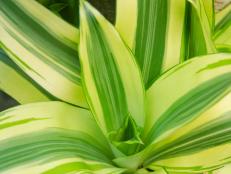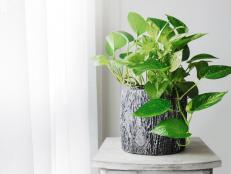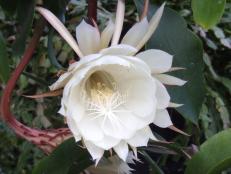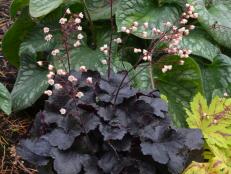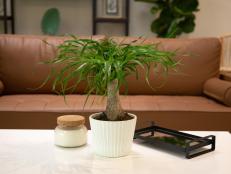Philodendron Micans Care
You’ll be tempted to "pet" the soft, velvety leaves on philodendron micans. These easy-to-grow, tropical beauties climb or trail and make terrific houseplants.

Shutterstock/Firn
Philodendron micans is favored for its heart-shaped, velvety leaves that emerge pink-bronze and mature to purplish-bronze and dark green.

What is Philodendron micans?
From their origins in Central America and the Caribbean, philodendron micans (Philodendron hederaceum var. hederaceum) have been introduced to Africa, Asia and other parts of the world where some grow wild and others are prized as houseplants. Over 450 known varieties of philodendrons have leaves in different colors and textures that vary from 3 or 4 inches up to 20 inches on long vines.
One of the most popular of these is Philodendron micans. It boasts heart-shaped, velvety leaves that emerge pink-bronze and mature to purplish-bronze and dark green. The undersides of the leaves are reddish-brown. Sometimes it's hard to find, but it grows easily from cuttings, so look for a gardener who will share.
Botanical Name: Philodendron hederaceum var. hederaceum
Common Name: Philodendron micans or velvet leaf philodendron
Bloom Time: Spring or summer, but rarely blooms indoors
Light Needs: Bright, indirect light
Hardiness Zones: 10-11
Height and Width: 8 to 24 inches
Growth Rate: Fast
Philodendron Micans Plant Care
Are Philodendron Micans Hard to Care For?
Micans plants are very low maintenance. They appreciate having their leaves wiped off with a damp cloth now and then so dust doesn't accumulate and block light. They also need repotting when they become root-bound or when the roots stick out of their containers. Philodendron micans grows fast and can live for many years with the right care.
Light Needs
Give philodendron micans bright, indirect light. Micans can survive as a low-light plant, but the vines become long and leggy and produce small leaves.
Can philodendron micans have too much light?
Yes. Hot or direct sun can burn the foliage. If your plant gets a lot of light, it will typically have red or maroon leaves. In low light, it will turn dark green. Philodendron micans grown as houseplants can get too much light when the seasons change, so move your plant to another indoor spot if needed.
Soil
These tropical plants need a loose, well-draining soil mixture that contains plenty of organic matter. Regular potting soil will work, but philodendron micans will do better in an airy, organic mix, such as one part peat moss combined with one part perlite and one part sterilized compost. Substitute one part coco coir for the compost if you prefer.
Water
Philodendron micans is forgiving if you neglect to water now and then. If you wait too long to water, its leaves will curl and droop. Overwatering can be harmful, too, so grow velvet leaf philodendron in a container with at least one good drainage hole and let the top 2 or 3 inches of soil dry out between waterings. Pour out any excess that collects in any saucer or tray you keep under the plant.
Temperature and Humidity
This jungle dweller needs warmth and humidity. Fortunately, the temperatures in most homes and offices are fine for philodendron micans as long as they're not exposed to cold drafts from windows, doors or vents, or kept too long in temperatures below 55 degrees.
Velvet leaf philodendrons will also grow in average indoor humidity although they'll do better if there's some extra moisture in the air. If you have enough light, try them in a bathroom or near a kitchen sink. You can also increase the humidity around them with a small room humidifier or by putting them on top of some pebbles in a tray or saucer filled with a little water. Don't let the roots touch the water. Misting can help, but the tiny water droplets evaporate fast.
Fertilizer
If your potting mix is high in organic matter, your philodendron micans won't need much extra fertilizer. A balanced, all-purpose fertilizer, applied as directed on the label and used in spring and summer, will usually be enough to help it grow.
Toxicity
Philodendron micans is toxic to people and pets.
If your philodendron micans starts to get leggy — which can happen if it's not getting enough bright, indirect light — cut the stems back during the spring and summer. Pruning when the plants are actively growing will encourage them to branch. The cuttings are easy to propagate, so don't toss them away. Don't prune off more than 25% of the growth at any one time.
Propagating Philodendron Micans
To propagate your velvet leaf philodendron, save the pruned stems or make cuttings with clean, sharp scissors or shears. Aim for 4 or 5 nodes on each cutting (a node is where the leaf attaches to the stem, although some stems have nodes without leaves). Take off all the leaves except for a few at the tips, so you expose at least one node.
Put the stem cuttings in a glass or jar of water and keep it in a warm spot out of direct sunlight. The nodes should stay under the water but keep the leaves out of it. Check often and refill the jar as needed to keep the nodes submerged.
When the roots are at least one inch long, plant the cuttings in loose, moistened soil enriched with organic matter. Keep the soil moist but not soggy. After a couple of weeks, cut back on watering and water the same way you water the parent plant — that is, when the top 2 or 3 inches of soil are dry.
Philodendron Micans Problems and Pests
Philodendron micans is relatively carefree. If you have other houseplants with pests like scale, mealybugs, aphids or spider mites, periodically check both sides of the leaves on your velvet leaf philodendron to be sure they don't get infested, too.
Treating pests can be as simple as knocking them off with a spray of water from your kitchen sink or bathtub. Wipe off mealybugs with a cotton ball or swab dipped in rubbing alcohol and scrape off scale with your fingernail or a toothpick. If you see tiny, sticky drops on your plant, don't stress. They're extrafloral nectaries, produced naturally to attract beneficial insects that help protect the plant against pests. They won't hurt your philodendron micans.
Philodendrons curl their leaves when they need water, but curling can also mean there's a problem with their roots. Roots can rot if the plant is overwatered or shrivel up and die if they go too long without water. If the leaves don't improve after watering, take the plant out of its container and look at the roots. If they're dry, try putting the plant into some water to see if new, healthy roots will form before you toss the plant into the compost heap. Mushy stems, yellowing leaves or blackened stems can signal overwatering or that the soil is staying too wet. Be sure your potting mix drains easily and that you dump out any excess when you water.
Do Philodendron Micans Climb or Hang?
The answer to whether philodendron micans climb or hang is both. Try them in hanging baskets or add a moss-covered pole, trellis or other support to a container so your plant can climb it with its aerial roots. If the vines become leggy and the leaves are small, the velvet leaf philodendron probably isn't getting enough light. Prune it back to promote new growth and check the light level. Fertilizing can also help the leaves grow larger.
Variegated Philodendron Hederaceums Micans to Grow
Some philodendrons are sold in small sizes, but hard-to-find varieties can be pricey.
- Rare 'Aurea' has leaves that change from neon green to gold, deep orange and finally cream.
- 'Velvet Halo' is a cultivar that can have white variegation on the leaf margins, along the center ribs of the leaves or in random places.
- 'Lemon Lime' is native to South America and tolerates lower light levels. Its stems with variegated yellow and green heart-shaped leaves can be trained to trail or climb.

Logee’s Plants for Home and Garden at Logees.com
Rare and hard-to-find, ‘Pink Princess’ philodendron (Philodendron erubescens) has foliage that changes from olive-green with white variegation to deep black with striking pink spots.
More Beautiful Philodendron Varieties to Grow
- 'Pink Princess' philodendron (Philodendron erubescens 'Pink Princess') has variegated pink and green leaves. Give it bright, indirect light to help it stay colorful, or it will eventually turn green.
- Philodendron Prince of Orange (Philodendron erubescens 'Prince of Orange') is a rare, non-vining plant that grows upright. Young leaves are vivid orange and sometimes turn shades of salmon, yellow and dark orange before aging to green. Because it's a patented hybrid, propagation isn't allowed without permission from the patent owner, even for personal use.
- Green Heartleaf Philodendron (sometimes shown as Philodendron scandens, Philodendron cordatum or Philodendron hederaceum): Let this philodendron climb a support or trail along a bookshelf or mantle. New leaves are dark green and become bronzish-green. The stems of this relatively slow-growing plant can reach 13 feet long if unpruned. Sometimes called the sweetheart plant because of its heart-shaped foliage, it can be confused with pothos (Epipremnum aureum).

.-Battle-on-the-Beach-courtesy-of-HGTV.-.jpg.rend.hgtvcom.196.196.suffix/1714761529029.jpeg)




